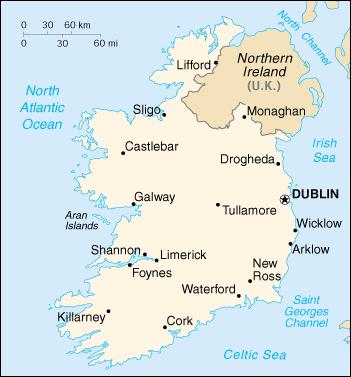| 
As was explained in the previous lesson, places in Ireland are troublesome at first. From a genealogist's
standpoint, the most effective way to understand Ireland is to realize
that it is made up of:
4 Provinces: Connaught, Leinster, Munster
and Ulster
32 Counties that started in the 12th
century
327 Baronies that were a subdivision
of a county that is now obsolete but in the 19th century was widely
used. Today it is replaced with the Poor Law Unions.
2,508 Civil Parishes that span across
both barony and county boundaries. Church of Ireland parishes usually
conform to the Civil parish but the Roman Catholic normally do not
except in those areas that are many Catholic. Usually Catholic parishes
are larger. The Roman Catholic Church due to the reformation in
the 16th century adapted to a new structure centered on towns an
villages. Londonderry has been subdivided into 46 Civil Parishes.
Thus the need to find the proper parish for your ancestor.
60,462 Townlands further divide the rural
areas of Ireland. Sources such as Griffith's Valuation
help to identify the exact place of residence of an ancestor within
a parish. The townland is the most ancient of Irish land divisions
and the smallest. These townlands were named early and often expressed
the environment surrounding the area. They vary greatly in size
with the largest normally referring to the least fertile areas.
The Gaelic names of these townlands were anglicized so it is important
to read early histories on the name to understand their relevance
to your Irish ancestor. This is true of other nations that were conquered at one time or another. You must understand the history.
The last jurisdiction, is the Poor Law Union.
This is the locality reference provided in the Census of Ireland
records. Especially helpful are those 1901 and 1911 census records
that are available now online. Check the registrar district to obtain
the Poor Law Union. This was the reference point provided for the
indexes.
In the period prior to the 1830s and 1840s, and the pulling together
of the Ordnance Survey maps of Ireland, there was no standardization
of spelling of townland names. Be aware of many spellings for these
localities. Townland names, originally in Gaelic, were anglicized
from the 17th century by settlers who had no knowledge of the Irish
language. An example is in the Clondermot Parish in County Londonderry.
The same townland appears as Coolkeeagh in Griffith's Valuation
of 1858, as Killkeeraugh in the 1831 census, and as Culkeeragh
in the Tithe Book of 1834.
By using Griffith's Valuation Maps, by understanding the purpose
of the maps, and by using aids to understanding the information
on the maps, you can identify with accuracy the location of the
ancestral home, even if it is now long gone. But that is a discussion
for another day.
Many place names do not appear on maps, but are written in the
records. And since Ireland was divided into a number of administrative
divisions which form the geographical basis for research, the more
precise and localized your knowledge of the address of your ancestor
(townlands in rural areas, streets in towns, or parish), the better
your chances of finding the family in the records of Ireland.
It is important to have access to a couple of good geographical
reference books for Ireland including:
General Alphabetical Index to the Townlands and Towns, Parishes
and Baronies in Ireland published by Genealogical Publishing
Company. A copy is available in the Family History Center in Monterey and in the Family History Library.
Also MOST helpful, is A New Genealogical Atlas of Ireland
by the same publisher available in many genealogical libraries.
|